Cyborgs in the Everyday – Inside Cybernetic Organisms
A select number of technologies we use in the present day would appear unreasonably futuristic to people living 20 years ago. What we think we understand about the concept of Big Data – which includes cyborgs, AIs, humanoids, and more – is just but the tip of an icebag. Furthermore, IoT (Internet of Things) devices are now plentiful – with most electronic equipment now giving you instant internet access.
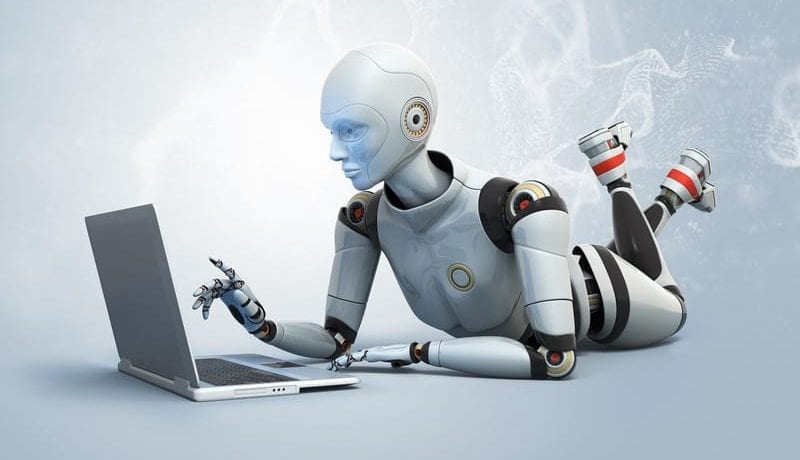
Consequently, most of these electronic devices/appliances will also offer you a host of onboard apps and features that an average user can easily use. Practically, everything about the vast internet information is now being simplified with a miniature computer that can fit your pocket. If you dare think about the incredible technological advancements, it’s not difficult to imagine a future where cyborgs will be part and parcel of our lives. However, the big question remains, what if the cyborgs are already a reality?
What Is a Cyborg?
Simply put, a cyborg is a being that utilizes both organic and technological systems to operate its tasks. This means that we can also define a cyborg as an organic being that either completely or partially relies on technological components. Oh, and it doesn’t need to be visually obvious.
However, different pop cultures hold different telltale instances of cyborgs. For instance, the Star Trek franchise shows borgs having sprouting wires, and electronics installed within their bodies. Sequentially, the DC comics superhero cyborg sports a body that’s mostly made of metal.
Arguably, if a human being is relying on any kind of technological enhancement – say artificial body organs or any tech advanced feature – then we can describe them as cyborgs. The word “cyborg” comes from two words – cybernetic and organism.
Reality Check: Are Cyborgs the Next Step in Human Evolution?
The idea of Cyborgs is not new. Whether it was technologically possible back then or not, people were aware of it. Yeah, it doesn’t matter if you were in the 80s and 90s. If you were anywhere near a comic book or a SEGA, you probably know what a cyborg is. Let me show you exactly what I mean by that.
Cyborgs in Movies and Comics
In 2017, DC Comics introduced its Cyborg character. You might have known him from the comics as he was created in 1980. However, in the most recent DC sequel, Justice League, we finally saw Cyborg in live-action.
The character [Victor Stone] sports a mind and a body that is much advanced, seemingly against his consent to create a superior version of a human.
Going by the classic comic book, Victor’s main task is to master and control his new powers. Also, he has to learn to overcome the feeling of being a danger to humanity.
The newly released movie, Alita: Battle Angel has once again shed light on the concept of cyborgs. Moreover, while we’re constantly growing our dependency on machines to function well, there’s a need to observe the laws of robotics.
According to Robin R Murphy – computer science and engineering guru from Texas A&M University – there’s a clear gap between the law and our ability to enhance your body and mind.
The starring character in the movie [Alita: Battle Angel] is a cyborg that has a mechanical body but houses a biological brain. And while most aspects of the movie are somewhat imaginative, most facts are plausible.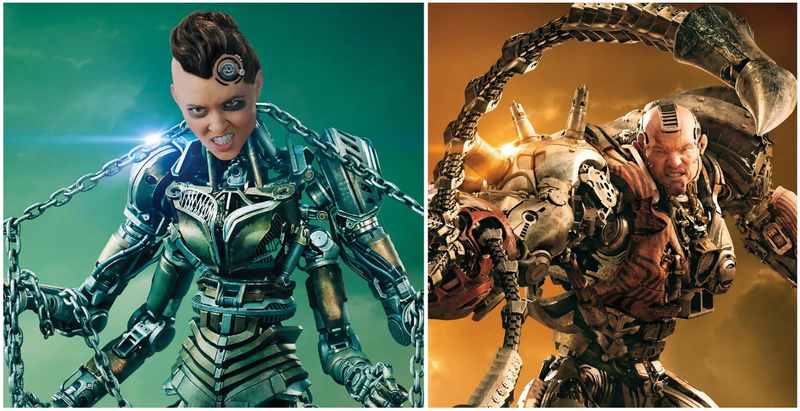
Another form of Cyborgs has to be my favorite, Mortal Kombat’s own Cyrax and Sektor. If you owned a SEGA back in 1995, I’m quite sure that you got yourself Mortal Kombat 3. 
The game introduced us to three cyborgs/humanoids, including the two mentioned above. There’s also Smoke, but he’s not as popular. These two are members of the Lin Kuei clan of assassins who underwent transformation into cyborgs.
The experiment added metal armor, weapons, and a brain chip (uploaded war memories. So, personally, when I was a kid, I was well aware of cyborgs, and so were you.
Neil Harbisson Developments
Neil Harbisson is a cyborg in real life. The Catalan-raised, and British-born is a contemporary artist who is popular for having an antenna in his skull.
Neil’s power is something that’s more poetic, and unlike most movie superhero cyborgs, he doesn’t resent his ability. Neil can hear colors. The antenna installed in his skull enables him to receive various audio signals that he can interpret into colors. Noteworthy, Neil is colorblind, but his natural ability has been enhanced, thanks to the implant.
In the past, Neil has created art to advance human senses. The cyborg activist produced paintings and piano concerts to enable you to understand how he perceives the world – of course, using his newfound sense.
Neil argues that technology has already entered our lives, so deep that we have to delegate some obligations to it. His view of the relationship between our lives and technology has allowed him to modify his natural senses.
Undoubtedly, we strongly rely on technology for various functions, including memory storage, calculations, data input, and output. And according to Neil, we sometimes use it to bend space and time – something that brings continents together.
Neil adds that even the most basic of tools – eyeglasses – help enhance your vision, and they’ve been around for more than seven centuries.
Furthermore, we’ve seen more enhancements on various body parts, such as digital hearing aids that are currently helping millions of individuals to experience better sound.
There are also prosthetic limbs that are aimed to help amputees to have sensory feedback – something that will allow you to feel touch again.
Moon Ribas Developments
However, your desire to enhance your body abilities doesn’t have to be influenced by your physical disabilities. Moon Ribas – an artist and co-founder at Cyborg Foundation – is also popular for having a sensor implant in her elbow.
The sensor implant enables her to experience seismic activity around the world via vibrations. With the help of her sensor implant, she’s able to receive online data through a mobile app – information about earthquakes that she often reads as movements.
Both Neil and Ribas convincingly see themselves as cyborgs – and they’re rightfully so.
Cybernetics vs. Transhumanism Explained
To conceptualize, cybernetics is an approach that explores the interaction, control, and other regulatory systems of any nature – whether it’s humans, animals, or AIs.
On the other hand, Transhumanism is a popular movement that often advocates for the belief that humans can enhance and transform their abilities. Furthermore, according to Max Moore:
“Transhumanism is a class of philosophies of life that seek the continuation and acceleration of the evolution of intelligent life beyond its currently human form and human limitations by means of science and technology, guided by life-promoting principles and values.”
The widely known philosophical movement explores the advantages, chances, and limitations of advancing our bodies through technology.
However, these possibilities – cybernetics and transhumanism – often bring controversial reactions to many. This is despite the great interest from various science fiction projects to exhibit these subjects, and they do so in extreme morbid methods.
A good example is one of the upcoming futuristic game – Cyberpunk 2077 – that’s scheduled to premiere in 2020. The game exhibits how humanity is decaying, where our bodies now heavily rely on enhancements to perform better.
However, the main thought-provoking questions remain unanswered. Is humanity slowly dying? Are we prepared enough to embrace cyborgs? Of course, several corporations are already helping us make these decisions without necessarily considering the downsides.
The Argument Against Human Augmentation
An article published in 2016 points out warning messages about the dangers of cyborgs from some of the world’s iconic figures, including Bill Gates, Nick Bostrom, and Elon Musk.
According to them, AIs and cyborgs are a time bomb waiting to go off. They talk of the dangers of human augmentations – stressing their fear about the possible decay of humanity.
In September 2019, Elon Musk is again talking about the future of cyborgs, only that this time, he’s controversial. He has a famous quote: “to secure humanity’s future as a civilization.” It now sprung mixed reactions from various figures around the world.
Literally put, Elon Musk is urging you to enhance your human brain with implants that will store your memory – something he hopes will help future generations to learn from.
His new startup Neuralink is purely referenced from various science fiction concepts. And while this movement is taking shape in the US, the concept of human augmentation has been existent in all of Europe for a while now.
For instance, Dr. Kevin Wrnick – commonly called Captain Cyborg – is a British university professor who’s known to have several implants in his body since the 90s. There’s also the likes of Neil Harbisson, and Moon Ribas – both of whom we’ve already talked about.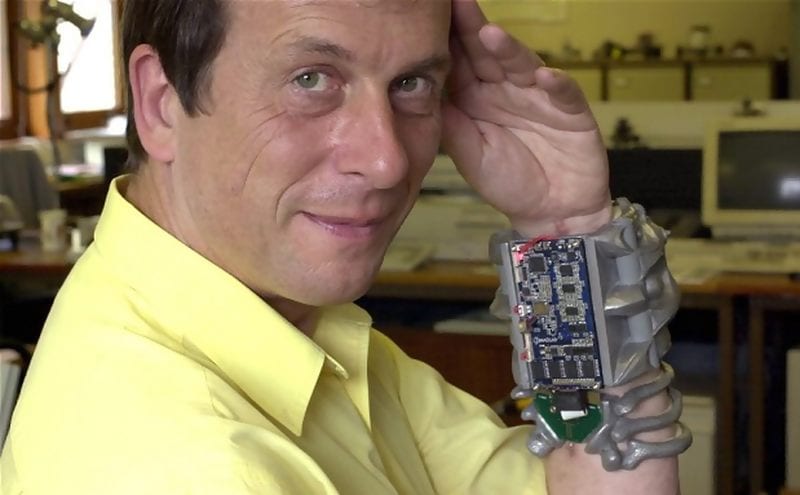
Consequently, several European startups have invested millions of dollars in projects aiming to hack the human brain. Moreover, startups like Britain’s Bios, Sweden’s Flow Neuroscience, and Netherlands’ Salvia Bioelectronics have collectively raised a staggering ten million dollars – in under two years.
Privacy and Security
The past several decades have seen major advancements in robotics, and this has made them [robots] a booming business. Whether it’s heavy machinery, car manufacturing, textiles, kids’ toys, or even hobbyist RC cars – they all fall under robotics.
Regrettably, we trust these types of equipment to be secure, but sadly they end up violating users’ security and privacy. And while this might seem like an alleged hoax – there’s a huge possibility of malicious attackers hacking into your seemingly safe and secure gadgets. Moreover, these threats are what make cybersecurity so vital for your connected devices.
In 2013, there was a famous campaign – stop-the-cyborgs – that raised its concerns about privacy ahead of the launch of the Google Glass. This is because Google Glass technology included recording your surroundings without your consent.
The Google wearable has since raised serious security concerns, albeit its ban in most public setups, including hotels, pubs, cinemas, casinos, and more. 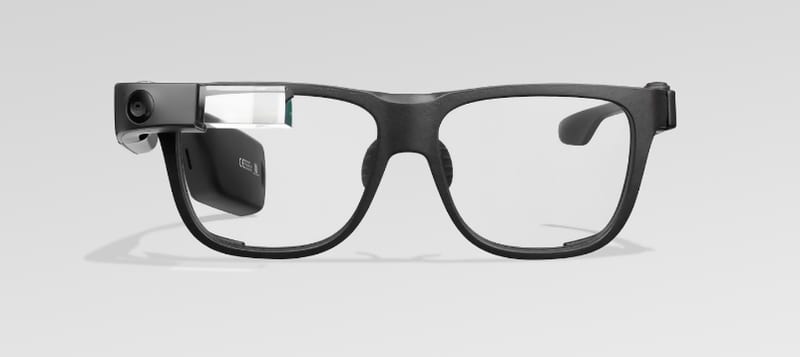
Furthermore, in 2015, Seth Wahle – a famous engineer, demonstrated how easy it is to hack various home devices and security systems. According to him, he can easily manipulate these gadgets with the help of an undetectable NFC chip implanted in his palm.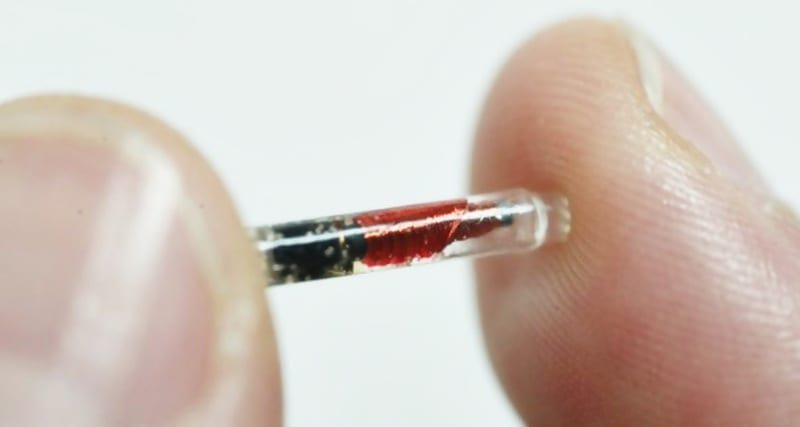
We’ve also seen privacy breaches from trendy AIs such as Amazon’s Alexa, and Apple’s Siri. These devices can spy on you and record private conversations without your consent.
For instance, in 2017, a UK resident returned home when he started hearing his Amazon Echo Dot device spitting random commands. We suppose that his previous interactions with the voice assistant generated these fragmentary commands.
This is because the uttered commands appeared to be train-ticket requests, as well as TV Show recordings. What’s even disturbing is that Martin had not uttered the usual wake-phrase, “Alexa,” something that usually activates the device.
Dehumanization
With the heightened influence of robots in workplaces and homes, brings the fear that humans might eventually do away with emotions. Undoubtedly, thanks to robot tech advancements, people will become emotionless machines. And considering that scientists are equipping AIs to think like humans and stripping cyborgs from empathy, the worst is yet to come. But how true is this?
The subject of what it entails to be human remains arguable. Furthermore, one can argue that organic body parts make you human. However, can be individuals with artificial organs and limbs be considered less human?
For instance, patients waiting for organ transplants use medical bionics. And according to stats, because of this, the artificial organ industry is expected to rise by about 9% annually – and that’s, to say the least. Soon, if not already, there will be mass production of artificial body parts (organs that are enhanced).
Gladly, specialists in the industry haven’t managed to construct a piece of equipment that can stimulate all the brain functioning – some good news, albeit debatable. However, while you may argue that replacing our body organs with artificial parts is unnatural, the real definition of natural is also evolving with time.
According to a survey published recently, your faith in religion will decide how you perceive dehumanization. The more religious you are, the less likely you’re to consider opting for artificial organs. And of course, not all religious faiths share this perception. For example, religions like the Christian Transhumanist Association maintain a neutral ground on the subject [dehumanization].
Inequality
Inequality is undoubtedly an obvious concern in the future of cyborgs. Opportunity to upgrade your body organs will initially if not mostly, be given to the privileged – something that has been existent since. Gennady Stolyarov – a transhumanist author, says:
“Some would express fear that emerging augmentations would create an arms race that threatens to leave behind those who choose not to be augmented.”
However, according to him, his theory assumes that not every person will seek to compete with the rest. In my opinion, I think it is logical. This is because these technological upgrades won’t be available to everyone at the same time – implying those with more influence, power, intelligence, and wealth will stand a chance to benefit the most.
Additionally, the concerns about inequality have also been portrayed in different aspects, in the past. For instance, in 2008, the Olympics denied Oscar Pistorius the chance to compete in the competition. This is because Oscar has more than 30% mechanical advantage of the allowed limit.
We also predict similar concerns that will arise in the future for intelligence sports like chess and gambling. Let’s face it; enhanced users can use their deep algorithms to win competitions. Consequently, to some degree, we feel this will trigger more participants to get upgrades.
Our Expectations
We don’t expect these technological advancements to happen all at once – something that might cause havoc. Instead, the evolution will and is happening gradually. It’s allowing every human to adjust and possibly grab a part of this inevitable transhumanism.
We also understand that while you might not fully embrace the change, there’s a section of users who will gladly opt for the artificial organs for better survival. Similar to the smartphone and other mobile devices adoption, we expect to embrace cyborgs without much opposition.
Biohacking Evolution
A recent study covered how famous consulting and research firm Frost & Sullivan discussed the three types of transhumanism. They include the evolving body, thought, and behavior. Nonetheless, here’s how the three types of transhumanism affect humanity in general:
Body Enhancement
Apart from regular hearing-aids, contact lenses, or mind-controlled prosthetics, humans can use other technologies to enhance their physical capabilities. This includes wearables, implants, as well as reprogramming body cells (DNA).
Wearables
Simply put, you’ll find equipment such as fitness trackers, health monitors, even smart clothing – linked to your phone. These are some of the wearables we anticipate to augment the way you’ll live in the future.
Notably, the most advanced wearables exist in the health sector. Even presently, you can find a list of wearables of all kinds. This includes fitness trackers, diet monitors, health monitors, and more than trendy users are using.
Consequently, you can use these wearables to monitor and store your health information. The data will act as a reference for future diagnostics.
A good example is the Fever Scout, which enables you to monitor the temperature readings of your body and your family in real-time – using an interface app.
There’s also the Go2Sleep device that you can wear as a ring, and it’ll monitor your heart rate, pulse, and oxygen levels – something that is quite economical compared to the expensive and complicated clinic tests.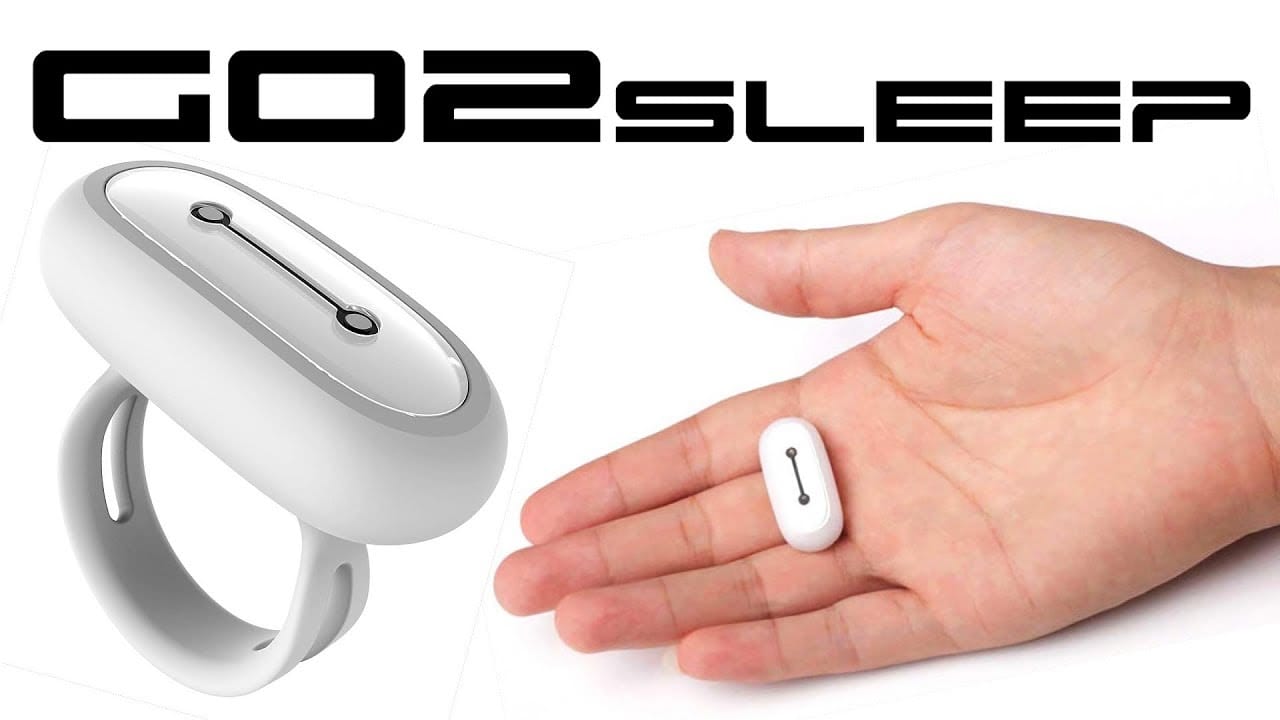
Moreover, according to the Rock Health research reports, there’s an increasing number of firms and individuals investing in the wearables industry. And according to them, these wearables are already attracting a considerable number of consumers – grossing billions.
Furthermore, healthcare wearables are posing superior chances in the manufacturing sector as well. For instance, North Star BlueScope Steel recently partnered with IBM to manufacture smart helmets and wristbands.
Employees then use these smart wearables to monitor their metrics. That’s not all. These smart wearables also warn them about hazardous areas they should avoid.
Another instance is where John Deere – the US agricultural equipment manufacturing giant – issues VR headsets to reviewers. The users can then use the wearables to determine the potential risks involved in assembling products.
Implants
Having implants on your human body is another way of enhancing yourself. And while implants come with their disadvantages, you have to admire the merits of installing implants in your body.
A good citing is Kevin Warnick, who is the first human to become a self-proclaimed cyborg. He was the first human to introduce microchipping into the world, and he did it by installing a chip on his left arm.
The chip would help him to have automatic control over his doors and computers in his lab. The RFID (Radio Frequency Identification) used in his implant sports similarities with the tech used in scan cards, as well as pet trackers.
Since then, the number of humans opting for implants has grown drastically. Bear in mind that you can now easily access these implants through popular sites like Dangerous Things – a biohacking retailer for hardware, tools, and other implants.
You can find products like NFC (Near Field Communication) chips that you can use for data transferring. Also, there are bio magnets that can lift small metallic objects – via touch.
However, there’s little known about the health risks of these implants. This is despite the proponent’s argument that the implants are not riskier than getting a body piercing or tattoo.
Nevertheless, the full potential of these implants hasn’t been realized yet. For instance, if you want to make swift payments with just a tap of your finger, then you’ll first need approval from your bank and the gateway payment system.
Thankfully, with the increasing demand for body-enhancing, it’s fair to anticipate the adoption of these implants.
Reprogramming Cells
Modifying the DNA of a human to cure diseases and possibly induce slow aging is one of the prospective initiatives of today’s science. Furthermore, the initiative is now a reality considering the recent genome editing – CRISPR-Cas9 – that has successfully cured two patients of leukemia.
Genome editing is simple and versatile. It is increasingly promising great success in treating various viruses as well as passing the enhanced genes to future generations.
Sadly, however, ethical concerns have significantly affected the mass adoption of this technology. Bear in mind that CRISPR has found breakthroughs to viruses like HIV, and helped manufacture revolutionary drugs.
Moreover, CRISPR could also help improve the overall intelligence of an unborn baby. It is these promises that raise concerns from moral, legal, and religious stands. This means that the methodology has to be studied in depth before it’s widely applied.
Thought Enhancement
Humans have always unknowingly enhanced their thought abilities with the aid of technology for a while now. For instance, you can save hundreds of contact numbers without having to memorize them.
Moreover, you can store all login information to your various accounts on your computer or phone. However, to what extent can we stretch our cognitive ability?
Cognitive enhancement includes any augmented data processing like perception, memory, attention, or the capacity to learn. Sequentially, the technology being used to enhance our thoughts is objectified. And even though postcards were created to help us predict the future, we still don’t store the data in our minds.
Behavior Enhancement
Sadly, human behavior enhancement, including augmented human empathy, decision-making, and collaborativeness, are poorly ventured. This is considering how these behaviors are of great concern for the anti-transhumanism campaigns.
Ideally, if human beings become less empathic or sport psychotic features as a result of technology – then we should find ways to improve our social lives.
Human behavior enhancement can be achieved by improving the need and ability to study. However, due to lack of discipline, and proper motivation, this is not possible, yet.
Michael Schrage – innovation leader and writer – introduces the term “Selvesware” to describe future personal assistants – bots. According to him, these data-driven and personalized cyborgs can study the behavioral attitudes of humans and execute them.
He claims that these bots will increase personal productivity by miles. Michael also criticizes current personal assistants like Alexa and Siri, which offer services and learn new skills every day.
He argues that they’re not equipped with the ability to acquiring external assistance – rather they only improve using analytics. However, we somewhat disagree with Michael.
If observing nature is anything to go by, then having robot employees take over industries and other social institution instead of humans is something of great concern.
Nonetheless, since we’re now entering a much advanced technological world, robots and cyborgs are inevitable. All the while, our only hope is that experts in the industry to try and find an organic balance between the social life of humans and the professional industry.
Are we ready for human enhancement?
In 2017, James Young qualified for a chance to receive a 3D-printed prosthetic arm that was inspired by his favorite game Metal Gear Solid. The arm was seemingly futuristic and quite powerful for tasks.
It also sports a USB port as well as a small drone device. But according to James, the arm was heavy. He admitted that he can’t wear the arm all the time. Scientists designed the arm to aid humans. It’s not a machine for mass production – and this is despite its high cost of manufacture.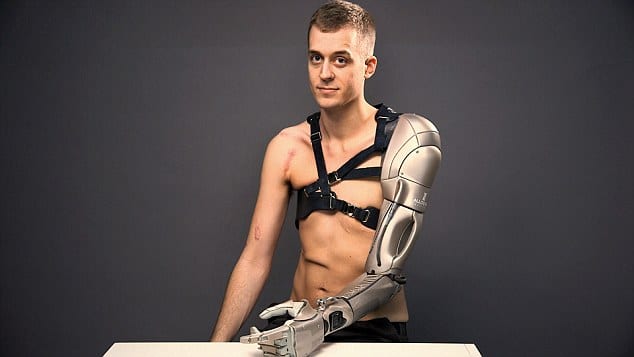
Admittedly, physically and mentally challenged, as well as other amputees are the ones who are likely to go after body enhancements to make their life better.
However, there are mixed reactions when people without disabilities also consider these enhancements. While the demand for chips is continuously growing, it’s not the same as opting to replace a body organ that is already working well.
Cyborgs In the Everday – Final Words
Transhumanism is on the rise, and though, its application remains varied. The understanding of human augmentation is what will make a smooth transition in the future. Being able to see the distinction between technology and biology is crucial.
However, the real question to ponder remains. How soon can we expect body enhancements for individuals who need them, as well as those who fancy them? You tell me, are you against Cyborgs invading our life? What do you think? Drop your comments below.





